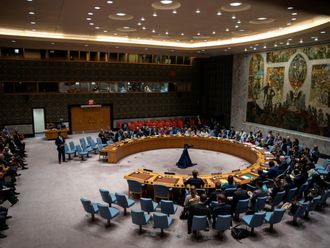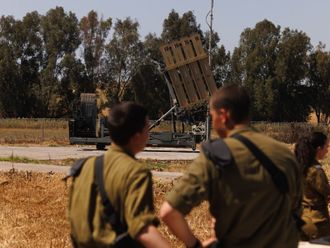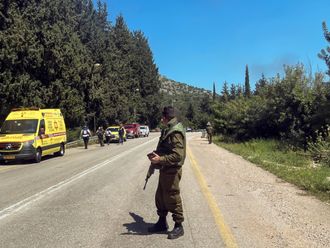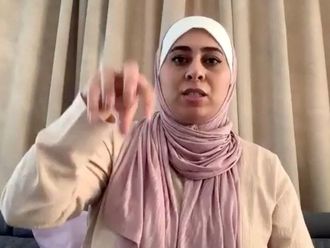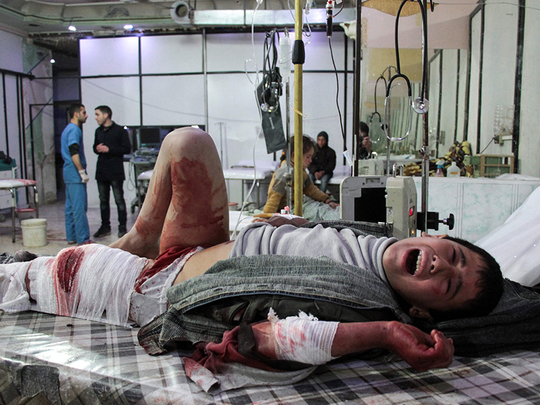
The fallout from Arab Spring protests in 2011 have bred instability, war and terrorism in the region.
While the brutal Russian and Syrian regime bombing of Aleppo in 2016 broke our hearts, 2017 hasn’t been any kinder.
Syrian village of Khan Sheikhoun
Mariam Abu Khalil, a 14-year-old resident who was awake, told the New York Times that she had seen an aircraft drop a bomb on a one-storey building.
The explosion sent a yellow mushroom cloud into the air that stung her eyes. “It was like a winter fog,” she said.
Another witness described the scene: “Kids were all over the floor, some dead and others struggling to breathe. The noise of them trying to breathe was loud, with foam all over their faces.”
Abdulhamid Al Youssef sobbed as he carried his infant twins, wrapped in matching white shrouds, to their final resting place.
Ahmad and Aya, nine months old, died in the attack along with Mr Youssef’s wife Dalal and 16 other members of his family.
In October the United Nations said that it had conclusive evidence that attack was carried about by the Syrian regime of Bashar Al Assad and that Sarin nerve gas was used.
Egyptian Church attacks
Just five days later, on April 9, Daesh terrorists carried out twin attacks on two Churches in Egypt as Christians gathered to pray on Palm Sunday.
At least 27 people were killed and 78 injured in an attack on the Church of Mar Gerges in Egypt’s Nile city of Tanta.
News footage from Tanta showed people gathering at the church, singing hymns. The video then quickly switched to bars as harrowing screams and cries echo in the background.
Hours later, a second suicide attack, hit the Saint Marks’ Church in the Mediterranean Sea city of Alexandria where Coptic Pope Tawadros II was leading a mass service inside.
He was not harmed. 16 people, including three police officers were killed and 41 injured in that attack.
Nabil Nader, who lived in front of the Tanta church, described the scene: “I heard the blast and came running. I found people torn up ... some people, only half of their bodies remained.”
Fadi Sami, an eyewitness to the Alexandria blast narrated: “There were bodies and body parts everywhere, outside and inside the gate. I saw a man put together what was left of his son in a bag.”
Terrorist attack in Mogadishu, Somalia
In the single largest terrorist attack this year, at least 500 people were killed on October 14 in the Somalian capital of Mogadishu.
The scale of the loss makes the attack, which involved a truck packed with several hundred kilogrammes of military-grade and homemade explosives, one of the most lethal terrorist acts anywhere in the world for many years.
Witnesses described bewildered families wandering among the rubble and wrecked vehicles, looking for missing relatives. Bodies were carried from the scene on makeshift stretchers made of blankets, as people tried to dig through the debris with their hands.
“There’s nothing I can say. We have lost everything,” said Zainab Sharif, a mother of four who lost her husband in the attack.
Muna Haj, 36, said: “Today, I lost my son. The oppressors have taken his life away from him. May Allah give patience to all families who lost their loved ones in that tragic blast … And I pray that one day Allah will bring his justice to the perpetrators of that evil act.” The Al Qaida-linked militant group Al Shabab was believed to be responsible for the blast.
Sinai Mosque killings
On November 24, militants stormed a mosque in Egypt’s North Sinai province, killing 235 people.
The al-Rawda mosque in the town of Bir al-Abed was targeted during Friday prayers.
No group claimed the attack, but militants affiliated with Daesh have been responsible for scores of deadly attacks in the province.
Witnesses said dozens of gunmen arrived in off-road vehicles and bombed the packed mosque before opening fire on worshippers as they tried to flee.
Pictures from the scene show rows of bloodied victims inside the mosque. At least 100 people were wounded, reports say, overwhelming hospitals.
Speaking to Gulf News, the mosque preacher recounted the events: “The terrorists were shooting randomly and without mercy. Some worshippers tried to escape from the mosque windows. Others sought refuge in the pulpit on which I was standing. The pulpit crashed under the pressure of the people. We all fell to the ground.”
Damascus attacks and starvation
Throughout the month of November, Ghouta, a suburb of Damascus, was relentless attacked by Syrian regime bombs while also suffering from starvation.
Forces loyal to Bashar Al Assad’s regime have long besieged rebel-held areas to push them to surrender.
The parents of baby Sahar recall their daughter’s last days “We feared our hugs might break her. She barely moved. She was too weak to cry. At times, her doctor thought she looked more like a skeleton than a month-old baby.”
Ribs protrude through shrunken skin. Her mother recounts: “We can only give her water, and it goes right through her. She sleeps for 15 minutes, and then she starts screaming again. I’m so tired.”


